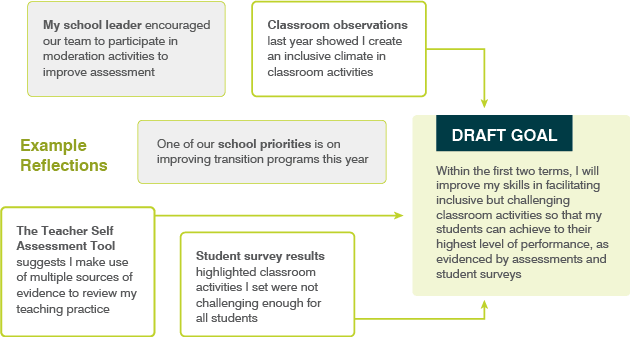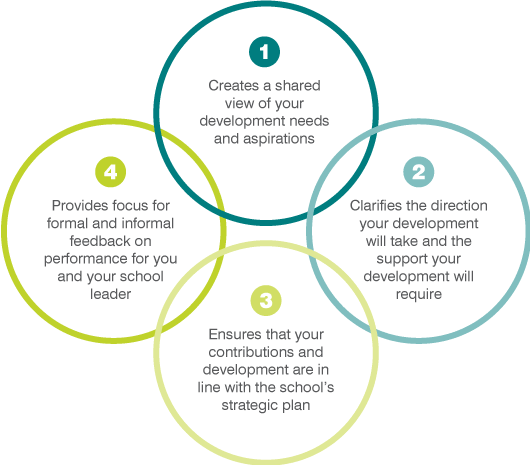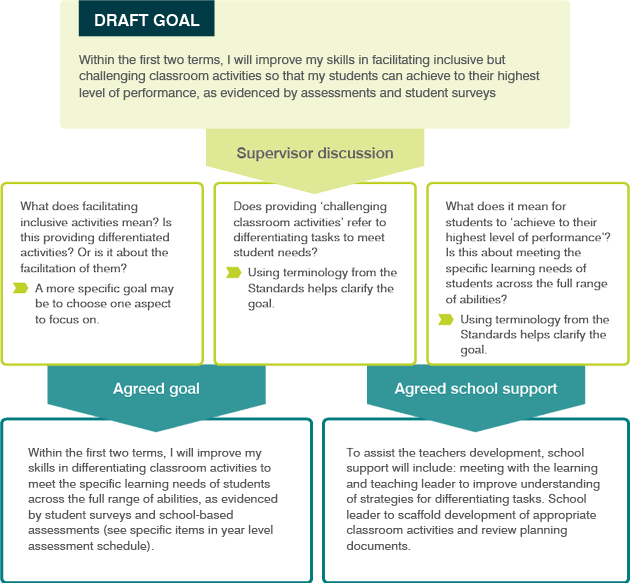Reflection can be a formal or informal learning experience that improves an individual’s professional practice and an education setting’s collective effectiveness.
Goal setting is a structured activity that will help you achieve planned and specific outcomes.
Both reflection and goal setting encourage evaluative thinking and play an important role in growth and development.
Learning environments move at a rapid pace, and it can be challenging to find time to reflect on the impact of your teaching practice. However, taking time for reflection can be an effective form of professional learning for teachers - stopping to consider
learning sequences or new initiatives, evaluating what has been successful and what changes need to be made. Learning from practice and contributing to a culture of improvement benefits teachers, leaders and students.
Watch the Reflections on teaching and learning video below
https://www.youtube.com/watch?v=XvYZ4jcNOCE
Video notes
American philosopher and teacher John Dewey described three attributes that support reflective practice. Having these attributes in the front of your mind can assist in reflection.
Wholeheartedness: a deep commitment to learning.
Responsibility: understanding you are responsible for your teaching practice and its impact.
Open-mindedness: the ability to learn and see areas for personal and professional growth.
Stephen Brookfield, leading scholar on critical and creative thinking, offers four lenses that can help you reflect on your practice from different perspectives.
- The autobiographical
Reflecting on your own experiences and pedagogical choices. - The learner
Considering learner perceptions and experiences; through learner perception surveys, formative or summative assessment and other observations. - Colleagues
Enabling shared experiences, which can be informal discussions or formalised through peer observation. - Theoretical literature
Undertaking reading, professional learning and research.
Reflection activity
Look at the matrix of reflective practices and identify which ones are in current use in your education setting.
The autobiographical | The learner | Colleagues | Theoretical literature |
|---|
Weekly reflection journal | Conducting student/learner surveys | Mentor/coaching relationships | Reading academic journals |
Self-reflection processes during teaching evaluations | Using on-the-go feedback tools | Peer teaching/ team teaching | Conducting action research |
Professional portfolios | Community feedback tools and opportunities | High-quality reflective professional conversations | Finding relevant case studies |
Is there one lens you’d like to make more room for, or one you’d like to improve in your practice? How will you do this?
Choose a practice above that you are already doing and gather evidence that demonstrates this practice. Evaluate your self-reflection below.
Selected reflective practice
Wholeheartedness: Do you commit to this practice regularly? Where in the content of your reflection can you find references to planning and monitoring your own learning?
Responsibility: How does your reflection critically reflect your impact? Are there opportunities to identity and celebrate effective practice?
Open-mindedness: Are the areas for improvement or review clear and explicit? How does this practice help identify opportunities for professional growth?
An education setting’s performance and development process offers an opportunity for teachers to engage in targeted development focused on priority areas for themselves, their setting and sector. Setting goals as part of the performance and development
process ensures improvements in practice are focused, challenging, and aligned to professional need and context.
Many education systems and sectors in Australia have their own specific performance and development processes that incorporate goal setting and professional learning plans. If you are unsure about your own context, reach out to a colleague or leader and
ask what processes are in place. The information in this section will complement or supplement your practice, inviting you to consider and apply what is relevant to you.
The most effective performance seems to result when goals are specific and challenging, when they are used to evaluate performance and linked to feedback on results, and create commitment and acceptance (Lunenburg, 2011).
This section takes you through a five-step approach to your goal setting.
Goal setting starts with reflection on practice to identify:
- strengths
- areas for development
- aspirations.
Reflection activities
Reflecting on practice
- Evaluate your teaching practice using a SWOT analysis or in accordance with the Standards using the Teacher Self-Assessment Tool.
- Put a critical lens on the biases and assumptions you bring to your practice and how you navigate cross-cultural communications and relationships. Use the Indigenous cultural responsiveness self-reflection tool for guidance.
- Consider feedback from previous Performance and Development reviews
Reflecting on setting
- Review your education settings’ goals and priorities. This can be done by reading annual reports, vision and mission statements and/or strategic plans.
- Consider feedback from leaders, peers, parents and learners. Hear from a diverse range of people to challenge your own biases and assumptions.
- Evaluate formal feedback such as observations, surveys and student achievement results.
Reflecting on system/sector
- Research your system/sector priorities and initiatives.
- Compare your performance and development reviews with the policies in your context. Consider the connection between the two perspectives. Do your goals mirror what is needed on a systemic level? How can you ensure your goals and practice embed system/sector
policies?
- Learn from peers by researching high performing teachers and strategies. Determine which aspects of
practice you admire and how changing your practice will impact on your own teaching/leading.
Activity
Complete at least one reflection from the ‘Reflecting on practice’ above and answer the questions below. Ensure that you include evidence in your answers.
What are your strengths? (example: I know that one of my strengths is developing relationships with students because of the feedback written in student journals. Gian wrote ‘I went to Miss Otero when I had a fight with my friend to help sort it out’).
What are your areas for development?
What are your aspirations?
It is important to develop a mindset of reflection as you work to improve your individual practice, the practice of others and that of the teaching profession to have the greatest positive impact on learners.
To turn reflective thinking into goals you need to consider the wider context. By looking at yourself as a learner in the context of competing priorities around you, there is a greater chance of planning and achieving relevant goals. Look through your
answers from the previous tasks and consider the following.
What would most impact learning, engagement and wellbeing of all your learners?
How can you integrate professional interests with education setting priorities and community needs?
Are there opportunities to align with system/sector policies and initiatives?
How can you foster high-expectation relationships with Aboriginal and Torres Strait Islander students and what can you achieve together? What is your current priority for continual development of culturally responsive practices?
How do you see yourself continuing to grow in proficiency across the career stages in the Standards?
Selecting a critical friend
In addition to reflecting on your own teaching philosophy and practice, establishing a critical friend and developing this relationship will give you a different perspective. A trusted colleague, mentor or leader is someone who can be with you on the
journey to help you develop and grow and continually improve your professional practice.
A critical friend is:
a trusted person who asks provocative questions, provides data to be examined through another lens, and offers critiques of a person's work as a friend. A critical friend takes the time to fully understand the context of the work presented and the outcomes
that the person or group is working toward. The friend is an advocate for the success of that work (Costa & Kallick 1993 p. 50).
To select a critical friend, consider your networks, both within and external to your education setting. You may have multiple critical friends who can help you to improve different aspects of your practice.
Some examples include: a curriculum leader, principal, or professional association network member, leaders of local Aboriginal or Torres Strait Islander organisations, and colleagues from other education settings.
Professional conversation
Discussing your reflections with your critical friend can help identify aspects of practice you may not have considered and to clarify your developmental needs. Based on this review of your reflections, and any instructions from your education setting,
draft a small number of goals that are challenging but achievable.
See the example below for how reflections can lead to a draft goal. Note the two reflections in grey that may inform another goal in this cycle or a future cycle.

Formulating SMART goals ensures your goals are clear to follow and achieve.
Specific: formulated in a way that you and others understand what is to be achieved. Think of the impact the goal should have and find a way to word the impact into one or two sentences.
Measurable: it should be possible to tell at any point in time whether or not you have achieved the goal. The goal will clearly link to the types of evidence collected throughout the review period.
Achievable: challenging but realistic. If a goal is not challenging enough then find a way to extend the expectation or shorten the timeframe. If the goal is not realistic, break it down into smaller parts.
Relevant: the achievement of the goal will relate to the Standards you are working on and will have meaningful positive implications for your teaching practice, student outcomes and the overall goals of your education setting.
Time-phased: the time in which the goal should be achieved is clear, whether it’s a few weeks, a school term, or a year.
You can use this SMART goal guide for annual goal setting as part of the formal performance and development cycle. It can also be used for goal setting in the context of a coaching relationship or for shorter-term goal setting resulting from personal
reflection, classroom observation or any other feedback.
(Note: If your education setting already has a goal setting template, then use the documents below as a reference point)
See the example filled in below.
Teacher’s name | Miss Smith |
School leader’s name | Ms Borg |
Review period | Term 1, 2022 |
Date completed | Week 2, Term 1 2022 |
SMART goal |
Specific What is your performance and development goal? | Improved skills in differentiating classroom activities to meet student needs |
Measurable What evidence will you use to demonstrate progression and achievement? | Student surveys and school-based assessments (see specific items in year level assessment schedule) |
Achievable What actions will you take to achieve it? | Peer observation, research, collaborative work with colleagues, leading to trialling a range of differentiated activities |
Relevant How does the goal connect to your professional growth, your education setting’s priorities, your students’ outcomes and the Standards? | I want to ensure I am meeting students’ needs. Student surveys highlighted the need for greater challenge. Appropriately challenging activities should lead to greater student achievement. This relates to Standard 1 ‘Know students and how they learn’ and Standard 3-‘Plan for and implement effective teaching and learning’. |
Time-phased When will you achieve the goal? | Within the first two terms |
What support do you require to achieve the goal? | Meetings with teaching and learning leader to improve understanding of strategies for differentiating tasks. Teaching and learning leader to scaffold development of classroom activities and review planning documents. |
Fill in the template below add further SMART goals as required |
Teacher’s name | |
School leader’s name | |
Review period | |
Date completed | |
|
SMART goal | Delete this SMART goal |
|---|
Specific What is your performance and development goal? | |
Measurable What evidence will you use to demonstrate progression and achievement? | |
Achievable What actions will you take to achieve it? | |
Relevant How does the goal connect to your professional growth, your education setting’s priorities, your students’ outcomes and the Standards? | |
Time-phased When will you achieve the goal? | |
What support do you require to achieve the goal? | |
+ Add another SMART goal
Creating and agreeing your performance and development goals with your school leader/supervisor is crucial because it:

Once you have drafted your goals you could meet with a critical friend to review and revise. They can help you assess if your goals are:
- appropriately challenging
- meeting your development needs
- following the SMART goal structure
- in line with setting and sector goals and priorities.
The process could look like this:

Regularly reflecting on your goals will help you gain an ongoing understanding of your achievement. This will help you monitor your progress toward your goal(s), assess the appropriateness of evidence, make changes as required and prepare for your annual
review. To best track your progress, you could also reflect on the types of evidence you are collecting to determine if they accurately or sufficiently demonstrate your development and impact.
Consider blocking out some time in your diary each week to allow for self-reflection as this is a useful way to refer to evidence to track progress. The structured matrix below will support the self-reflection process allowing you to move closer towards
your goal achievement.
Self-reflection matrix activity
This activity will direct your thinking to evaluate the success of your goals and the next step forward. You can use it during short periods of reflection throughout the life cycle of the goal.
See here for an Exemplar.pdf
Goal | |
Step 1: Plan and conduct activities Seek out activities that will support your goal. For example, observing a colleague, reading, professional learning. | |
Step 2: Evaluate effectiveness After participating in the activities, assess your progress so far. What helped? | |
Step 3: Locate strategies and resources Using what you know about the barriers and enablers for this goal, identify who can offer support and assistance, and if there is anything new you can try. | |
Step 4: Assess your performance Determine how much progress you’ve made. If you have met your goal, are you ready for a new one? | |
Self-reflection on-the-go
Below is a template for a pocket-sized card that allows for quick reference of your goals and self-reflection. Capture each goal in a couple of words and note them on the left side. Then print, fold and laminate the card for easy reference.

Download pocketbook-sized template as pictured above
Move forward to:
Alternatively, return to the